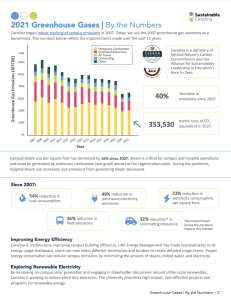Our 2021Greenhouse Gases: By the Numbers report breaks down campus emissions and illustrates the strides the University is making toward its 2040 climate neutrality goal. The report uses 2007 — the year Carolina began robust tracking of campus greenhouse gas emissions — as the baseline year.
Since that time, campus greenhouse gas emissions are down 40%. In 2007, the University emitted 589,237 metric tons of carbon dioxide equivalent and in 2021, Carolina emitted 353,530 MTCO2e.
Overall emissions in 2021 exceeded 2020 emissions, but this was expected as campus became more active following the first year of the pandemic. We expect to see an uptick in the 2022 report as well, with most campus operations back to pre-pandemic levels.
“It is gratifying to see the progress toward the University’s climate action goals. We still have work to do, but we have a clear and ambitious plan with metrics to measure our progress,” Chief Sustainability Officer Mike Piehler said.
By the Numbers Video
Stationary Combustion
The Cameron Avenue Cogeneration Facility is often referred to as a coal plant. In fact, it uses both natural gas and coal to create steam for campus labs and hospitals. A campus energy outage could spell disaster for patients at the hospital and the University’s $1.2 billion research enterprise. Recognizing this, and the role fossil fuels play in climate change, Carolina is working to move the cogeneration facility away from coal as quickly as possible, while retaining the required resilience of our energy system. Since 2007, we’ve reduced coal consumption by 54%, with more progress in the last three years than in the decade prior.
As Carolina staff works to identify a long-term solution for an alternative fuel source, short-term strategies have helped decrease our stationary combustion emissions. For example, in 2019, a burner restoration projected allowed Carolina to increase natural gas use and decrease reliance on coal. Even though steam consumption increased by 4% from 2020 to 2021, combustion only increased 2% following this project.
Carolina recognizes increasing natural gas use is an interim solution. The University is researching and monitoring alternative fuels for feasibility and researching technologies that can improve carbon capture, which would mitigate emissions.
Purchased Electricity
Stationary combustion produces electricity as a byproduct, but the University needs additional electricity to power campus. Approximately 15-20% of electricity comes from the facility, and the University purchases remaining electricity from Duke Energy.
To decrease our reliance on purchased power and mitigate emissions from this source, the University has invested in on-campus solar generation. In total, Carolina has 70 kW of rooftop solar panels, which produce 25,000 to 60,000 kWh annually. The Renewable Energy Special Projects Committee funded our most recent PV panels, found on top of the Curtis Media Center. Recognizing the relatively low emission reduction potential of on-campus panels alone, we continue to engage in discussions with campus and community partners about utility-scale renewables.
Our utility Duke Energy doesn’t currently offer a program that would make financial and environmental sense for Carolina, but we continue to analyze ways to make existing programs work while also engaging directly with Duke Energy around new programs that could work better.
Air Travel
Carolina researchers, athletes, and study abroad students travel over 80 million miles annually. Expectedly, emissions for air travel showed a decrease compared to previous years in 2021. These numbers are calculated based on the number of miles flown or the amount of money spent.
Although hybrid and virtual conferences continue to take place in the community, it is expected researchers will increase travel in the coming years. To decrease these emissions, which typically account for 10% of our total emissions, the University is looking into travel-specific carbon offset programs to see if this would be an effective way to decrease net greenhouse gas emissions.
Commuting
In 2021, it’s estimated that commuting led to 22,196 MTCO2e in emissions. Compared to 2019 – our last “normal” year – commuting emissions dropped by 40% in 2021. However, some of this decrease is due to the nature of the pandemic and increase in more remote and hybrid options.
The increase in electric vehicles on the road could marginally help campus commuting emissions on campus. There are currently six EV charging stations across campus, with more planned for installation in the coming years. Carolina is also fortunate to have a fare-free bus system on campus and within the surrounding communities. Through a $1.3 million Federal Transit Administration grant and $400,000 in funding from RESPC, there are three electric buses currently on the roads with an eight more on the way.
Unfortunately, emissions from commuting trended upwards prior to the pandemic due to more employees driving alone to campus. UNC Transportation and Parking’s Commuter Alternative Plan encourages employees to take sustainable transportation to the office by offering incentives like free regional bus passes and discounts at local businesses.
It’s important to note that commuter data always have high uncertainty due to the nature of collection. As the University’s commuter survey is updated, we’ll be able to have a more accurate measure in years to come.
Other
The other category calculated for our “By the Numbers” report includes emissions associated with our fleet, ground travel, food purchases, paper purchases, solid waste, wastewater, refrigerants/chemicals, upstream natural gas, and electrical transmission and distribution losses.
In 2021, Carolina’s vehicle fleet marked a record low for emissions, at 1,560 MTCO2e, or 0.5% of the University’s total emissions. There was also a 37% decrease from the 2007 baseline of 2,428 MTCO2e. This decrease is not completely attributable to the pandemic; fleet vehicles use 94% biofuel blends as fuel. Fleet services works across departments when purchasing vehicles, to ensure proper vehicles are selected based on their primary purpose.
